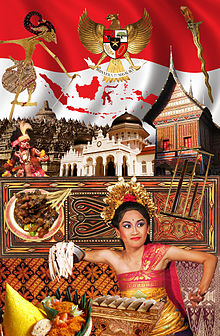 Oleg Balinese dance performed by a pair of dancers | |
| Native name | Tarian Indonesia |
|---|---|
| Instrument(s) | Indonesian music |
| Inventor | Indonesian |
| Origin | Indonesia |
| Part of a series on the |
| Culture of Indonesia |
|---|
 |
| People |
| Languages |
| Mythology and folklore |
| Cuisine |
| Literature |
| Music and performing arts |
| Sport |
Dance in Indonesia (Indonesian: Tarian Indonesia) reflects the country's diversity of ethnicities and cultures. There are more than 1,300 ethnic groups in Indonesia.[1] Austronesian roots and Melanesian tribal forms are visible, and influences ranging from neighboring Asian and even western styles through colonization. Each ethnic group has its own dances: there are more than 3,000 original dance forms in Indonesia. The old traditions of dance and drama are being preserved in the numerous dance schools which flourish not only in the courts but also in the modern, government-run or supervised art academies.[2]
For classification purposes, the dances of Indonesia can be divided according to several aspects. In the historical aspect it can be divided into three eras; the prehistoric-tribal era, the Hindu-Buddhist era, and the era of Islam. According to its patrons, it can be divided into two genres; court dance and folk dance. In its tradition, Indonesian dances can be divided into two types; traditional dance and contemporary dance.
UNESCO announced the traditional Saman dance from Aceh province as a world Intangible Cultural Heritage on 19 November, 2011, in Bali. Saman dance is unique due to its speedy movements and the harmony between dancers.[3]
On 2 December 2015 UNESCO also announced Three Genres traditional Balinese dances from Bali province as a world Intangible Cultural Heritage.[4]
- ^ "Mengulik Data Suku di Indonesia". Badan Pusat Statistik. 18 November 2015. Retrieved 12 February 2020.
- ^ "The Indonesian Folk Dances". Indonesia Tourism. Archived from the original on 24 November 2010. Retrieved 30 November 2010.
- ^ Abdussalam, Andi (19 April 2011). "UNESCO to recognize Aceh's Saman dance". Antara News.com.
- ^ "Warisan Budaya Indonesia". kemdikbud.com. 2 December 2015.